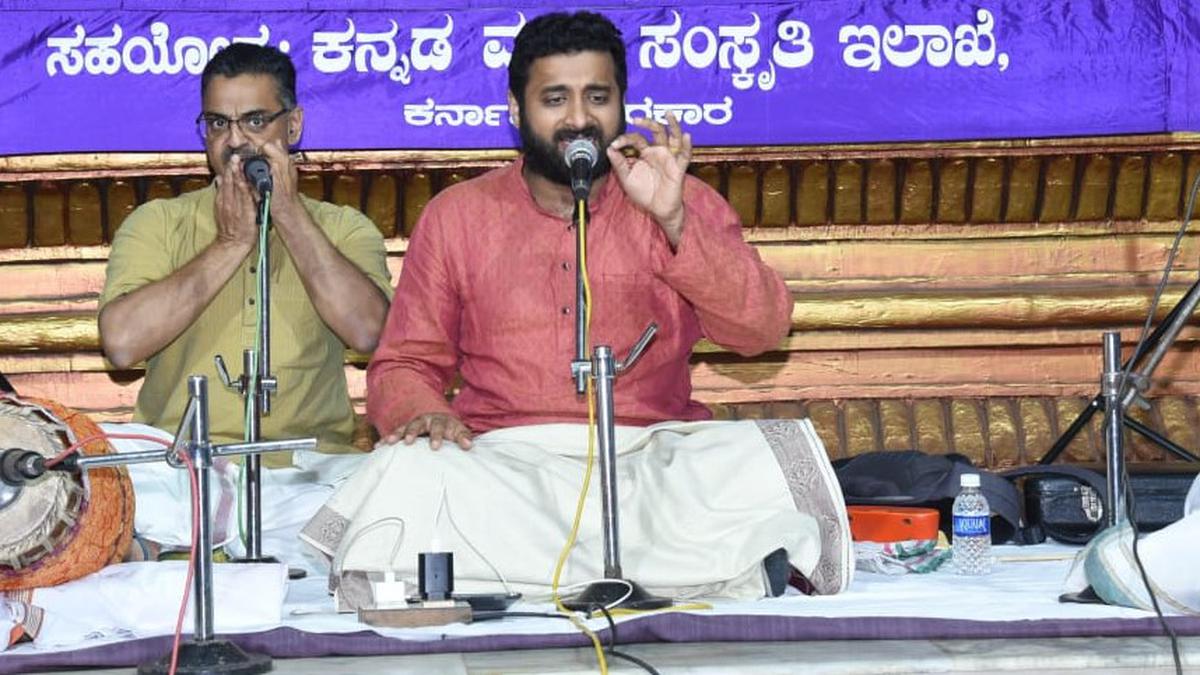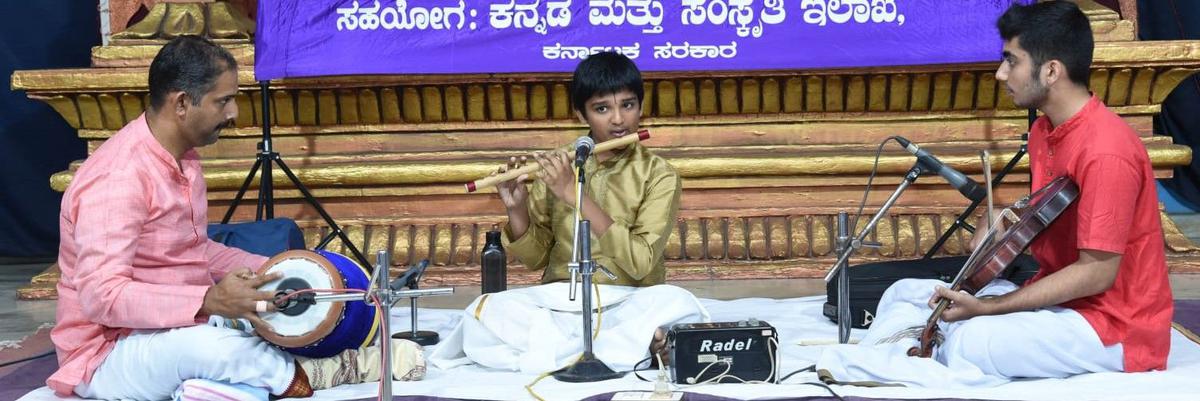- February 27, 2024
It was a display of technique and talent at Sangeetha Parishad, Mangaluru

Vivek Moozhikulam performing at Sangeetha Parishad, Mangaluru.
| Photo Credit: Special Arrangement
Vivek Moozhikulam presented a spirited Carnatic vocal concert under the auspices of Mangaluru’s Sangeetha Parishad, in association with Karnataka Government’s Department of Kannada and Culture and Bharatiya Vidya Bhavan, Mangaluru. This is the Parishad’s 30th anniversary (Thrimshath Sambhrama) and it has been organising monthly concerts featuring both up-and-coming and established artistes.
Endowed with a majestic voice, Vivek began with the Saveri Varnam ‘Sarasooda ninne’ by Patnam Subramania Iyer, and quickly moved on to ‘Swaminatha paripaalaya aashu maam’ in Nattai by Muthuswami Dikshithar. He presented Papanasam Sivan’s masterpiece ‘Kaa vaa vaa’ in Varali with impeccable diction. Saint Tyagaraja’s compositions monopolised his concert. His delineation of Saramathi was full of fresh phrases, and, as expected, he presented ‘Mokshamu galadaa’. As a contrast, ‘Shobillu saptaswara’, in praise of the seven notes, followed briskly in Jaganmohini.
Bhava-rich delineation
The central piece was ‘Raksha pettarae doraku’ in Bhairavi. After an elaborate and bhava-laden delineation of the raga, Vivek rendered the kriti with due dignity and appropriate ornamentation. In this Utsava Sampradaya kriti, Tyagaraja sings about placing an auspicious mark (raksha) on the forehead of Rama to ward off evil eyes. (In many houses, this used to be a regular ritual during twilight. That is why this time is referred to as ‘sayaraksha’). Tyagaraja takes the liberty to treat Rama as a small child who needs to be protected. In the same kriti, he enumerates the greatness of the Lord, too. The niraval for ‘Sangeetha priya tyagaraja’ had flashes of briga-laden sangathis, delivered with effortless ease.
Keshava Mohan Kumar followed the vocalist faithfully through his soulful repartess on the violin. Mridangam by Sunaada Krishna Amai spread sunaadham (pleasant sound), and he supported the artiste with sensitivity. During the thani, along with Balakrishna Hosamane (morsing), Sunaada wove enjoyable rhythmic patterns.
The lighter session comprised Purandaradasa’s padas, ‘Mandha mathiyu naanu’ and ‘Rama nama payasake’. While both of them were lyrically rich, the latter delighted the listeners with its metaphorical beauty, describing the process of preparing payasam. The devotee mixes the sugar named Krishna, and ghee named Vittala into the kheer named Rama, serves it in a plate and enjoys it till he gets two burps of bliss.
Vivek concluded his well- planned concert with a thillana.

Pranav Adiga’s flute recital at Sangeetha Parishad, Mangaluru.
| Photo Credit:
Special Arrangement
Mature approach
In the earlier session, young flautist Pranav Adiga from Udupi (disciple of Varijakshi Bhat and K. Raghavendra Rao), endeared himself to the audience with his childlike face and a performance far beyond his age. With brief alapanas, he presented ‘Sudhamayee sudhanidhi’ in Amritavarshini (Muthiah Bhagavatar) and ‘Tatvameruga taramaa’ in Garudadhwani (Tyagaraja). After a satisfying alapana of Simhendramadhyamam for his main piece ‘Needhu charanamulae’, (also by Tyagaraja), Pranav showcased his talent in swarapratharas and concluded with ‘Govinda ninna namavae chanda’ by Purandaradasar in Jana Sammodhini.
The talented flautist was ably supported on the violin by Gowtham Bhat P.G. and Shailesh Rao on the mridangam.




